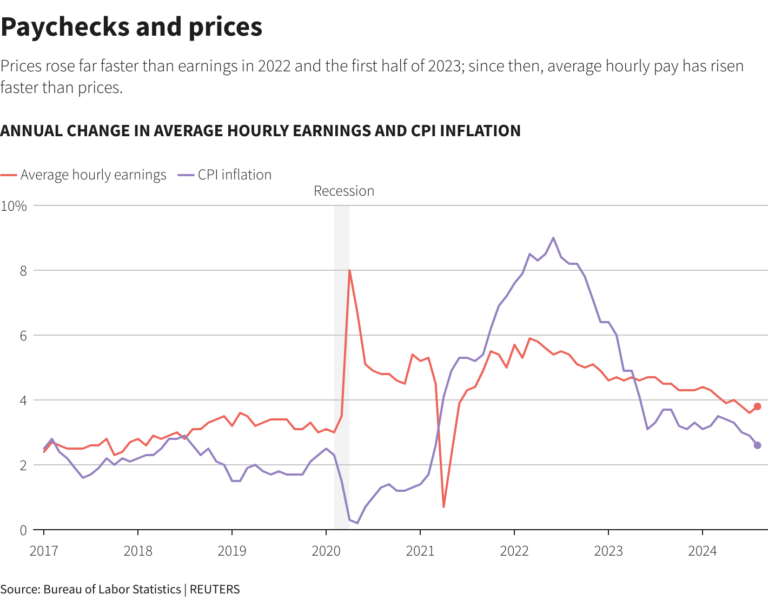Getty Images; Jenny Chang-Rodriguez/BI
- The Federal Reserve is expected to cut interest rates by 25 basis points on Thursday.
- It follows a 50-basis-point rate cut in September — the first cut in four years.
- The Fed forecasts another quarter-point rate cut in December, but it depends on upcoming data.
The election isn’t the only important event facing Americans this week.
On Thursday, the Federal Open Market Committee will announce its next decision on interest rates, and it’s likely to be another cut. CME FedWatch, which forecasts interest rate changes based on market predictions, estimated an all-but-certain 25 basis point cut as of Friday afternoon.
The Fed cut interest rates by 50 basis points in September — the first cut in four years and one twice the size of the central bank’s typical 25-point increments — following aggressive inflation fighting as the country recovered from the pandemic.
Fed chair Jerome Powell said during remarks at a Nashville conference in late September that “if the economy performs as expected,” it would mean two more 25-basis-point cuts this year. As the November and December meetings were the only two remaining in 2024 at the time of those remarks, that would mean standard-size cuts at both.
“Overall, the economy is in solid shape,” Powell said. “We intend to use our tools to keep it there.”
There have been several data releases since the last rate cut that suggest the economy is in good shape. September’s jobs report showed unemployment fell that month. Recent price index data shows headline inflation has slowed. Real gross domestic product rose at an annualized rate of 2.8% in the third quarter, similar to the 3% growth in the second quarter.
The last major data release before the meeting held some bad news, but with a catch. October’s jobs report published this past Friday, at first glance, showed a big slowdown. The economy added just 12,000 jobs over the month, far below the forecast of 106,000. However, the data was heavily affected by thousands of workers on strike at Boeing and other companies, as well as Hurricanes Helene and Milton, which likely drove that headline figure artificially down and did not reflect a slowing but still strong underlying labor market.
In October, 512,000 people in nonfarm industries didn’t work because of bad weather, around eight times the previous 20-year October average of 63,000. The unemployment rate — for which BLS said data collection was less affected by the hurricanes — was unchanged from September’s 4.1%.
Cory Stahle, an economist at the Indeed Hiring Lab, told Business Insider that October’s jobs report “validates the recent rate cut we saw from the Federal Reserve and probably keeps them on their rough timeline with continuing to offer cuts to keep the labor market strong.”
Meanwhile, inflation is near the Fed’s target rate of 2%. The personal consumption expenditures price index, which is closely watched by the central bank, increased 2.1% in September from September 2023, a cooldown from the previous 2.3%. Core PCE, which excludes volatile food and energy prices, rose at 2.7% for the third consecutive month. The year-over-year rise in the consumer price index has also slowed down.
A cooling job market and slowing price growth gives the Fed “further confidence in their ability to cut rates without reigniting inflation,” Julia Pollak, chief economist at ZipRecruiter, told BI.
It will take some time for Americans to feel the impact of September’s rate cut, along with any upcoming ones, because of lags in industries like housing, cars, and credit cards.
“Borrowers should understand that ‘falling interest rates’ are not the same as ‘low interest rates,'” Greg McBride, Bankrate’s chief financial analyst, said in a commentary. “Quite the opposite, as interest rates are high and will only decline to ‘not as high’ as 2024 comes to a close and we move into 2025.”
Powell has maintained that he will make decisions solely based on data. Despite the upcoming election this week, he has repeatedly said politics remain separate from the central bank.
“Our job is to support the economy on behalf of the American people, and if we get it right, this will benefit the American people significantly,” Powell said during a September press conference. “It’s something we all take very, very seriously. We don’t put up any other filters. I think if you start doing that, I don’t know where you stop,” he added.
What are your financial plans if the Fed makes another rate cut? Email these reporters at [email protected] and [email protected].
